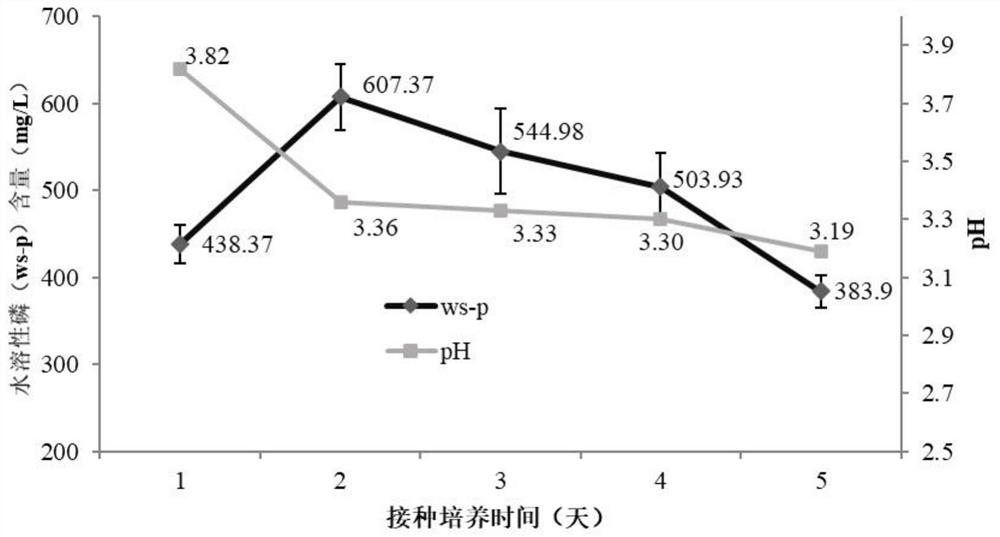A kind of Pseudomonas phospholytica and application thereof
A technology of Pseudomonas and monas, which is applied to Pseudomonas phosphate and its application field, can solve the problems of increasing phosphorus release, inefficient absorption and utilization, eutrophication of water bodies, etc., and achieves the promotion of plant growth. , the effect of improving the effectiveness
- Summary
- Abstract
- Description
- Claims
- Application Information
AI Technical Summary
Problems solved by technology
Method used
Image
Examples
Embodiment 1
[0016] The isolation of embodiment 1 phosphate-dissolving bacterial strain PD171
[0017] Heavy metal-contaminated soil samples were collected from the Dabaoshan mining area in Shaoguan City, Guangdong Province. Weigh 10g of soil sample into 90mL sterilized double-distilled water, shake at 180r / min for 30min, and then use 10-fold gradient to gradually dilute the soil solution to 10 -1 ~10 -5 100 μL of bacterial suspensions with different dilution gradients were taken and spread on different PVK solid medium plates. After culturing at 30°C for 3 days, the strains with different morphologies that produced transparent circles were picked and placed on TSA medium for isolation and purification, so as to finally isolate and obtain strain PD171.
[0018] PVK solid medium: glucose 10g, Ca 3 (PO 4 ) 2 5g, (NH 4 ) 2 SO 4 0.5 g, yeast extract 0.5 g, NaCl 0.3 g, KCl 0.3 g, MgSO 4 ·7H 2 O 0.3g, FeSO 4 ·7H 2 O 0.03g, MnSO 4 ·H 2 O 0.03g, agar 15.0g distilled water 1000mL, pH ...
Embodiment 2
[0020] Classification and Identification of Example 2 Bacterial Strain PD171
[0021] Phenotypic characteristics: The strain PD171 was inoculated on TSA medium by three-section line method, and the colony morphology was observed after culturing at 30°C for 3 days. The cultured colonies were taken for Gram staining, and samples for transmission electron microscopy were prepared, and the cell morphology of the strains was observed with a Hitachi H7650 transmission electron microscope. For the test methods of fluorescein, pyocyanin, oxidase, catalase, methyl red, and hydrolyzed starch, refer to the "Common Bacteria Identification Manual", nitrate reduction, indole, β-galactosidase, hydrolyzed gelatin, hydrolyzed seven Yeling, arginine dihydrolase and other tests use API 20NE reagent strips (Mérieux Bio, France). For the hemolysis test, blood plates were inoculated and cultured at 30°C for 7 days to observe whether there were hemolysis circles.
[0022] Strain PD171 is light yel...
Embodiment 3
[0029] Example 3 Phospholytic ability analysis of Pseudomonas phospholyticum PD171 in NBRIP medium
[0030] Use R2A liquid medium to activate Pseudomonas phospholytica PD171, cultivate and grow to the logarithmic phase at 30°C and inoculate it into an Erlenmeyer flask containing 40mL NBRIP liquid medium at 30°C The shaker was shaken at 180r / min, and the sterilized R2A liquid medium not inoculated with Pseudomonas phospholytica PD171 was added as a control, and 4 replicates were set for each treatment. From the third day, samples were taken every 24 hours and monitored until shaking culture for 7 days. The samples collected at different times were first centrifuged at 12000r / min, and the supernatant was filtered and sterilized with a 0.02 μm sterile filter membrane, and then stored in a freezer at -30°C until determination. The content of water-soluble phosphorus (ws-p) in samples collected at different times was measured by molybdenum-antimony anti-colorimetry, and the pH val...
PUM
 Login to View More
Login to View More Abstract
Description
Claims
Application Information
 Login to View More
Login to View More - R&D
- Intellectual Property
- Life Sciences
- Materials
- Tech Scout
- Unparalleled Data Quality
- Higher Quality Content
- 60% Fewer Hallucinations
Browse by: Latest US Patents, China's latest patents, Technical Efficacy Thesaurus, Application Domain, Technology Topic, Popular Technical Reports.
© 2025 PatSnap. All rights reserved.Legal|Privacy policy|Modern Slavery Act Transparency Statement|Sitemap|About US| Contact US: help@patsnap.com



